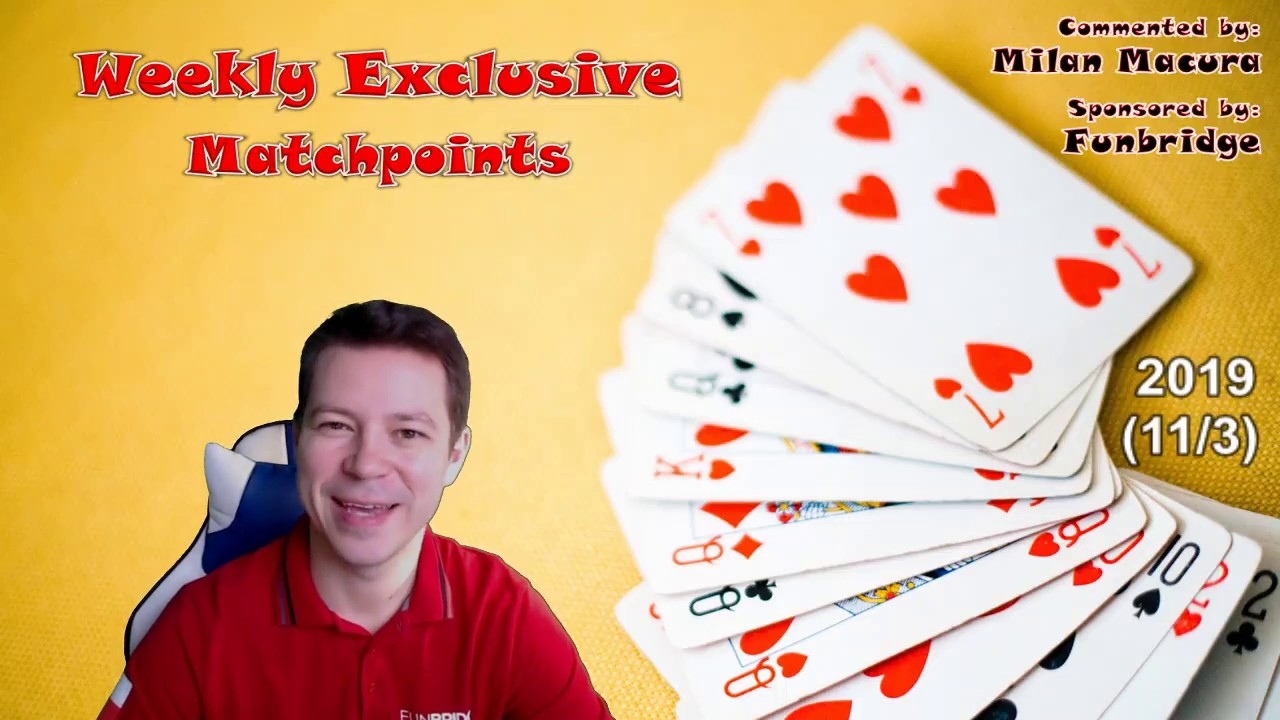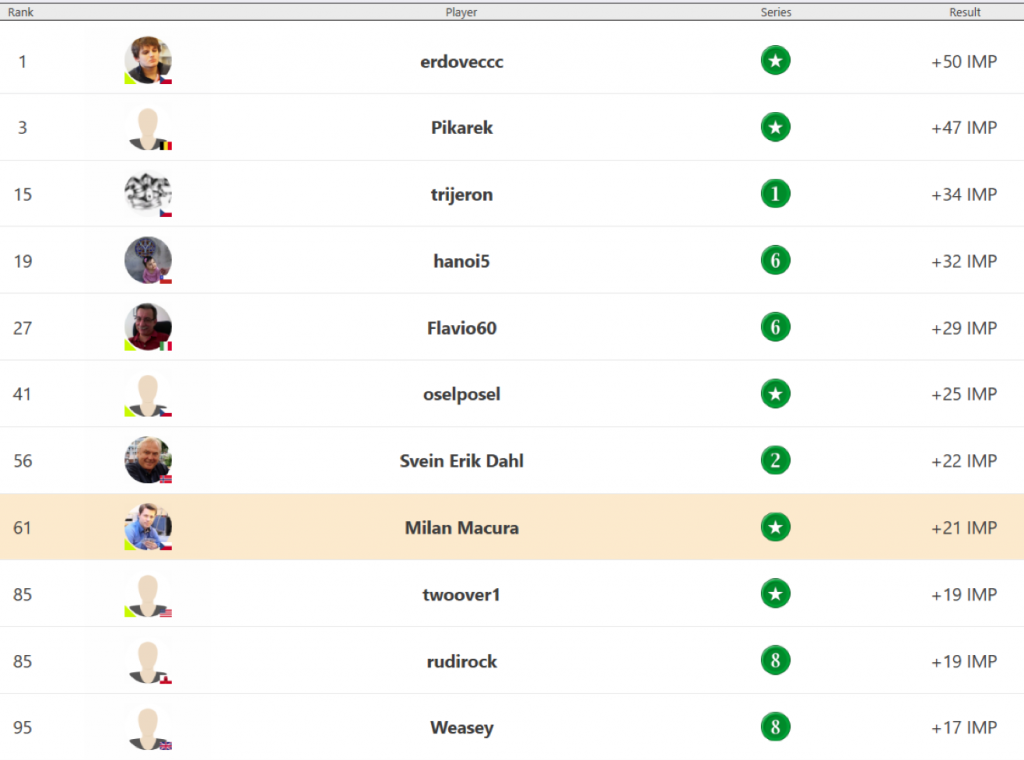
Milan Macura’s Exclusive Tournaments – November – #3
The participation in the weekly exclusive tournaments has stabilized with 620 players in the MP tournament and 821 players in the IMP one.
MPs results
I thought it would never happen but it is possible to win such a tournament with a solid bridge play.
I am glad I can present the full video of me scoring 76.50% and my first victory in the Weekly Exclusive Tournaments.
The other top 3 players are Francis de Lucy (FRA) with 74.32% and belle-mere (FRA) with 73.22%. Luc Bellicaud (FRA) managed to get to the top 5 of my friends’ list where we have a strong Czech group for the first time.


IMPs results
The one who managed to reach both slams could easily get over 30 IMPs.
But two players crossed the 50 IMP line, namely Erik Klems (CZ) and James Mason (UK) with +51 IMPs. Third place goes to Steven de Donder (BE) with +47 IMPs.
There has been quite a lot of players who played the tournament after the live stream and even if I believe that they have played fair, I cannot include them on the list.
Here are the screenshots I took immediately after I finished playing all boards live so they don‘t fully match final scores.


Here is the winning games list for the MP tournament

As you can see from the list, I had two standard scores on boards 3 and 5 but all the rest was top scores.
It is highly important to avoid disasters in such short tournaments. It means that if you have to make a risk-related decision, you should consider if you want to risk top-zero or if you are OK to get an average score.
A 40% score can be covered by one good score over 90% but a 10% score is almost impossible to recover in a short tournament.
Start solid, take a risk if needed but gamble maximum once per tournament!
Board 3 of the MP tournament is a great illustration of how the above statement can influence your decision making.

You can recognize the ideal hands for taking risks immediately. I call them ‘goulash’, i.e. 11 cards in two suits or an eight-card suit.
If you want to gamble, you can pass such hands and hope that you will get doubled later and make the contract.
The definition of the gamble is that you don’t have it under control because partner will never give you such a hand for an unexpected auction.
Start solid means opening 1♥ and wait and see what happens in the first round of bidding so you can make a decision later – take a risk or stay solid.
On this board, partner responds 2♦ (forcing to game in my setup). Since partner is the strong one, you should be considering going to slam.
What is the best way to find the information you need?

You are missing 3 aces. You can ask for them using Blackwood and ask partner if he holds the ♥Q too. Spade losers can be discarded on diamonds or ruffed if partner has a 3-card heart fit and only a doubleton spade.
Jumping to 3♥ is the best way to show you have a solid suit and extras.
Partner can either show a bad hand with 3NT or start cuebidding (showing controls) with extras. After a 3♠ cuebid by partner, you want to take over the initiative by jumping to 4NT immediately because showing more cuebids does not help to find the right information.
Partner shows 3 aces and you are again facing an important decision.
Do you want to go solid, risk or gamble?
Gamble = 7NT.
Risk = 6NT or 7♥.
Solid = ask for the ♥Q and if partner does not hold the ♥Q and an extra king, stay at 6♥.
I chose the near-solid approach and asked for kings only. Partner showed none so I stayed in 6♥, scoring 61.77%.
Here is the full board. Are you happy if you gambled or took a risk?

When you see dummy’s cards, it seems to be the perfect hand to gamble in 7♥, not that much in 7NT.
West has a difficult lead. The most natural is a spade lead which immediately gives you one more trick for the ♠J.
When you cash the ♥A, trump problem is solved.
The last piece of the puzzle is how to get rid of the fourth spade. You can either take a finesse in diamonds, ruff two rounds of diamonds and hope the ♦K drops or ruff the third round of spades.
Everything works on this board so all the gamblers were rewarded.
7 players
gambled in 7NT for 99.50%.
17 players took a risk in 7♥ for 97.51%.
78 players took a risk in 6NT, scoring 13 tricks for 89.80%.
262 players played solid in 6♥, scoring 13 tricks for 61.77%.
45 players made a mistake and scored less than 10% .
If you want to gamble, bridge is not the game you should play. It can work once or twice but in the long runyou will keep losing as you do mostly in casinos. The winning approach is to play solid and take a risk when it is the right moment. Easy to say, much harder to follow.
DON’T LOSE YOUR HEAD WHEN TAKING A RISK DOESN’T WORK
MPs are more suitable for risks then IMPs because every board has the same final value. We can now have a look at how expensive a risk in IMPs can be and how much you can gain if you find the right moment.
You are holding the following hand. How would you plan the bidding?

You have a solid 1NT opening and after you accept partner’s transfer to spades, Argine shows the club suit followed by a club cuebid when you show the spade fit.

If you are playing with your regular partner, you have 3 different ways to show your strength:
- With a maximum hand, ask directly for key cards with 4NT
- With a minimum hand, return to the trump suit with 4♠
- With extras, show the control in diamonds or hearts if you lack diamond honor
Although the hand is a maximum in HCPs, most of the honors are in partner’s short suits so I have evaluated it as a hand with extras only.
Partner showed the heart control which still indicates doubts.
Gamblers will go directly to a slam but I wanted to bid solid. I have asked for key cards and stopped in 5♠ as partner does not hold the ♠K and ♥A.
It is fine to play a slam if it depends on one out of two finesses or a split but it is gambling if you need a split of a suit plus finesse.

Bidding the slam is a reasonable action but is still risky. It depends only on the club finesse and you have an extra chance that opponents make a mistake.
In reality that happened in many cases and therefore most people who risked the slam were rewarded.
Surprisingly, a lot of people made the slam even after the ♥A lead because West switched to diamonds and East went up with his King.
Declarer can now discard four clubs on ♥Q and three diamond winners.
170 players bid 6♠ and made for +12 IMPs.
114 players bid 6♠ and went down for -13 IMPs.
The majority of the field stayed in 4♠, scoring 11 or 12 tricks for -2 IMPs and -1 IMPs respectively.
That means the risk can either benefit you greatly or pull you down if it doesn’t work. If you even make a mistake and you go down instead of making, it costs 25 IMPs. That is often the difference between being a winner or loser.
Videos of Milan Macura’s tournaments
MPs tournament video
Subscribe to be notified directly when my next video is online! Click on the button below:
IMPs tournament video
You can find all the boards of the IMPs tournaments in the video I posted on my YouTube channel. Don’t forget to Subscribe to so you don’t miss my next Exclusive tournaments analysis.
And if you didn’t know it yet, know that I challenge 5 of you at the end of each IMP tournament video!
My previous exclusive tournaments analysis are available here.



